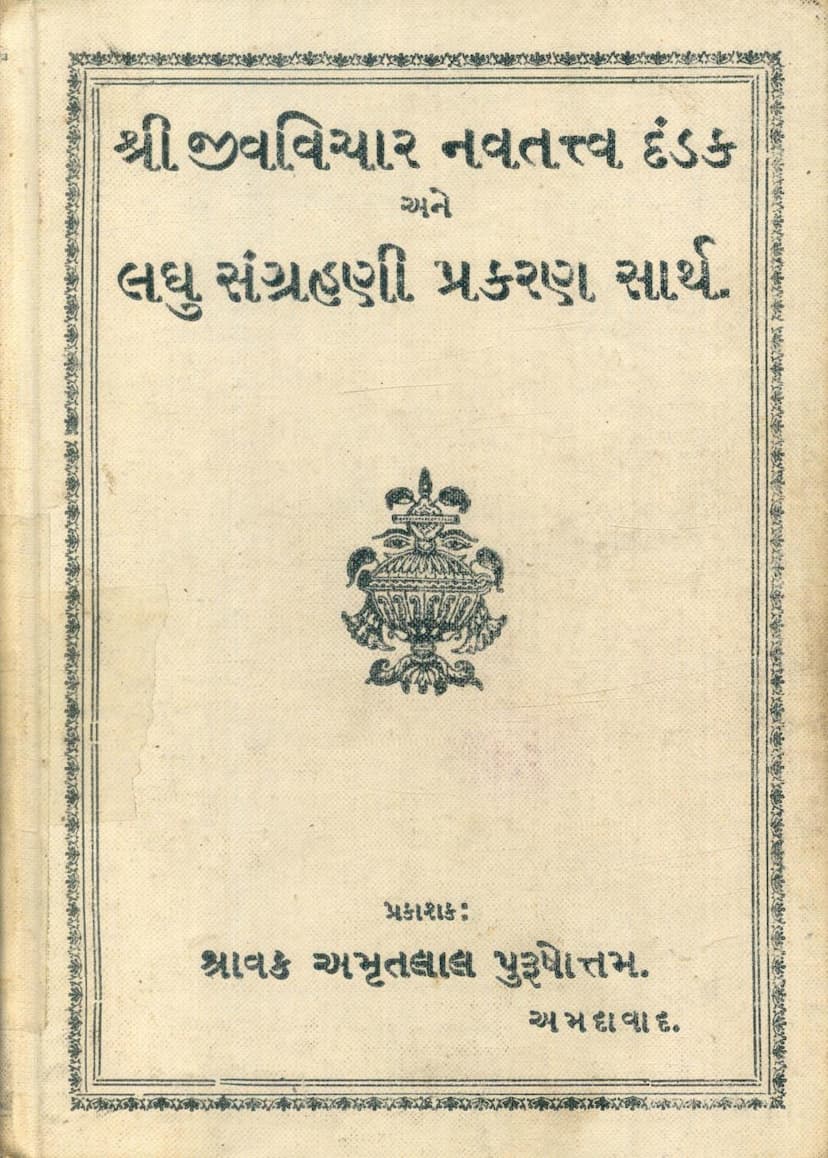Jivvichar Navtattva Dandak Ane Laghu Sangrahani Prakaran Sarth
Added to library: September 2, 2025

Summary
This document is a comprehensive Jain text titled "Jivvichar Navtattva Dandak Ane Laghu Sangrahani Prakaran Sarth" (Collection of Essence of Jivvichar, Navtattva, Dandak, and Laghu Sangrahani) authored by Vinayvijay and published by Devji Damji Sheth. It is a detailed exposition of fundamental Jain philosophical concepts, particularly concerning the nature of souls (Jiva), the nine realities (Navtattva), classifications of beings (Dandak), and principles of Jain conduct.
The book is structured as a compilation and explanation of various Jain scriptures and teachings. Here's a breakdown of its key aspects:
Core Subject Matter:
- Jivvichar (Study of Souls): The primary focus is on understanding the different types of souls (Jiva) based on their sensory faculties (Indriyas), their life spans (Ayushya), their physical proportions (Avagahana), and their destinations (Gati) like infernal beings (Naraki), sub-humans (Tiryan), humans (Manushya), and celestial beings (Deva). It meticulously categorizes souls based on their classification into immobile (Sthavar) and mobile (Trasa) beings, further detailing the sub-categories within each.
- Navtattva (Nine Realities): The text explains the nine fundamental principles or categories in Jainism:
- Jiva (Soul): The sentient substance.
- Ajiva (Non-soul): The insentient substance.
- Punya (Merit): Karmic influx leading to happiness.
- Papa (Demerit): Karmic influx leading to suffering.
- Asrava (Influx of Karma): The channels through which karma enters the soul.
- Samvara (Stoppage of Karma): The means to prevent karma from entering the soul.
- Nirjara (Shedding of Karma): The process of dissociating existing karma from the soul.
- Bandha (Bondage of Karma): The entanglement of karma with the soul.
- Moksha (Liberation): The state of freedom from karma and the cycle of birth and death.
- Dandak (Classifications of Beings): The text provides a detailed breakdown of the 24 classifications of beings, likely referring to the different types of souls within the Jain cosmological framework. It outlines these classifications based on their number of senses, life forms, and other characteristics.
- Laghu Sangrahani (Concise Compendium): This section likely serves as a summary or an appendix to the larger discussions, providing concise explanations or summaries of key Jain concepts, possibly including geographical descriptions of the Jain universe (like the Ardha-dvipa, or half-continent).
Key Features and Content:
- Detailed Classification: The book offers an exhaustive classification of living beings, starting from the most basic forms (like earth-bodied souls) and progressing to more complex ones, including the various types of celestial beings, infernal beings, and the intricate divisions of humans and sub-humans.
- Cosmological Description: It includes descriptions of the Jain universe, mentioning continents (dvipas), oceans, mountains, and the spatial arrangement of different realms where various beings reside.
- Karmic Principles: The text delves into the concept of karma, explaining its influx (Asrava), stoppage (Samvara), shedding (Nirjara), and bondage (Bandha), which are central to understanding the soul's journey towards liberation.
- Ethical and Spiritual Guidance: Implicitly, the detailed classifications and explanations serve as a guide for understanding the suffering of living beings and the path to avoid harm, thus encouraging practices like non-violence (Ahimsa) and compassion.
- Scriptural References: The text mentions the origin of these teachings from revered Jain figures like Arihant Parmatma, Ganadhar Maharaj, Acharya Shanti Suriji Maharaj, and Acharya Haribhadra Suri, highlighting the scriptural basis of the content.
- Accessibility: The publisher's note indicates an effort to make the book accessible with clear explanations, vocabulary meanings (shabdarth), verse explanations (gatharth), and useful commentaries (upyogi vivechan). It also mentions the inclusion of diagrams (naksha of Ardha-dvipa) and structured questions to aid learning.
- Emphasis on Knowledge for Liberation: The preface emphasizes that understanding the true nature of the soul is crucial for practicing non-violence, gaining true knowledge, and ultimately achieving liberation (Moksha).
Structure and Presentation:
- Gutharth (Verse Explanation): The text presents scriptural verses (Gathas) and then explains their meaning in detail.
- Shabdarth (Word Meanings): Key terms are defined to enhance comprehension.
- Vivechan (Commentary): In-depth explanations and elaborations on the concepts are provided.
- Question and Answer Format: The inclusion of questions at the end of chapters or sections suggests a pedagogical approach, encouraging active learning.
- Tables and Diagrams: The reference to a table (koshtak) and maps of Ardha-dvipa indicates a visual and organized presentation of information.
Overall Purpose:
The book aims to provide a clear, simplified, and accurate understanding of essential Jain philosophical doctrines. It is intended for students and scholars of Jainism to deepen their knowledge of the soul, karma, and the path to spiritual emancipation. The emphasis on "pratham vritti" (first edition) and an aim to keep the price low suggests a mission to disseminate this knowledge widely.
In essence, the "Jivvichar Navtattva Dandak Ane Laghu Sangrahani Prakaran Sarth" is a foundational text for anyone seeking to understand the core tenets of Jainism, offering a systematic and detailed exploration of the spiritual journey from the myriad forms of life to the ultimate state of liberation.